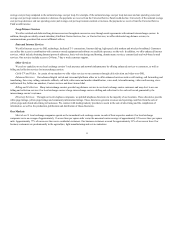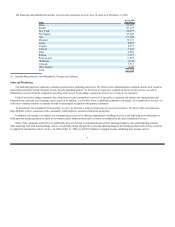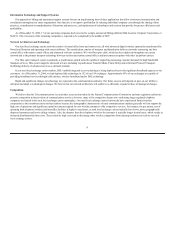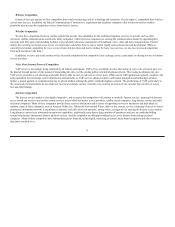FairPoint Communications 2006 Annual Report Download - page 18
Download and view the complete annual report
Please find page 18 of the 2006 FairPoint Communications annual report below. You can navigate through the pages in the report by either clicking on the pages listed below, or by using the keyword search tool below to find specific information within the annual report.
Communication Commission stated its intention to develop a long-term plan based on forward looking costs upon the expiration of the five-year period on
May 30, 2006. Prior to this expiration date, the Commission extended the embedded-cost mechanism until such time as the Federal-State Joint Board on
Universal Service recommends and the Commission approves a replacement universal service distribution mechanism. The Multi Association Group plan
created a new universal service support mechanism, Interstate Common Line Support, to replace carrier common line access charges and the recovery of
certain costs formerly recovered through traffic sensitive access charges. A recent Federal Communications Commission order merged long term support into
its interstate common line support mechanism without reducing (at least initially) the aggregate universal service support from the two mechanisms (both of
which had been previously transformed from access charge revenue streams into universal service support mechanisms). As a result of these changes, when a
competitor is designated as an eligible telecommunications carrier, it also receives an increased level of Universal Service Fund support equal to the level
received by the incumbent on a per line basis.
The Federal-State Joint Board on Universal Service and the Federal Communications Commission are currently considering revisions to both the
collection and distribution mechanisms for universal service funds. Universal service funding is currently collected through a surcharge on interstate and
international end-user revenues. Declining long distance revenues, the popularity of service bundles that include local and long distance services, and the
growth in the size of the fund, due primarily to increased funding to competitive eligible telecommunications carriers, are all causing the Federal
Communications Commission to consider alternative and more sustainable means for collecting this funding. An alternative under active consideration would
be to impose some form of surcharge on telephone numbers and/or network connections. Concerning fund distribution, in March of 2005 the Federal
Communications Commission issued new rules to set more stringent requirements for competitive eligible telecommunications carriers to obtain universal
service funding. Despite these changes, the overall size of the fund continues to grow, and the Joint Board and the Federal Communications Commission are
seeking means to control this growth. In August of 2006 the Joint Board released a Public Notice requesting comment on the possible use of reverse auctions to
determine recipients of high-cost universal service reform. It is unknown at this time exactly what course the Federal Communications Commission will take
on universal service distribution reform, but it is possible the remedy ultimately selected by the Commission could materially affect the amount of universal
service funding we receive.
In addition, there are a number of judicial appeals challenging several aspects of the Federal Communications Commission’s universal service rules. It is
not possible to predict at this time whether the Federal Communications Commission or Congress will require modification to those rules, or the ultimate
impact any such modification might have on us.
Potential Internet Regulatory Obligations
In connection with our Internet access offerings, we could become subject to laws and regulations as they are adopted or applied to the Internet. There is
currently only limited regulation applicable to the Internet. As the significance of the Internet expands, federal, state and local governments may adopt rules and
regulations, or apply existing laws and regulations to the Internet, and related matters are under consideration in both federal and state legislative and regulatory
bodies. The Federal Communications Commission is currently reviewing the appropriate regulatory framework governing broadband access to the Internet
through telephone and cable operators’ communications networks. We cannot predict whether the outcome will prove beneficial or detrimental to our
competitive position. In February 2004, the Federal Communications Commission initiated a proceeding to examine the regulatory implications of VoIP
technology. We cannot predict the results of these proceedings, the nature of these regulations or their impact on our business. Recently there have also been
discussions of “net neutrality” or the potential
16
























